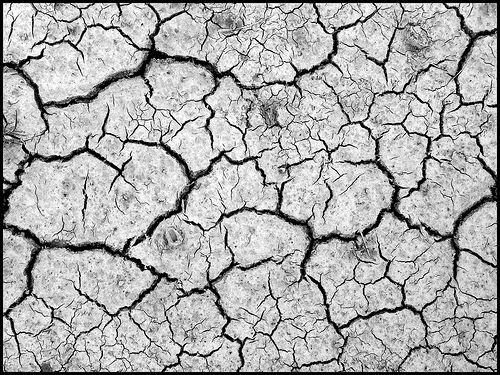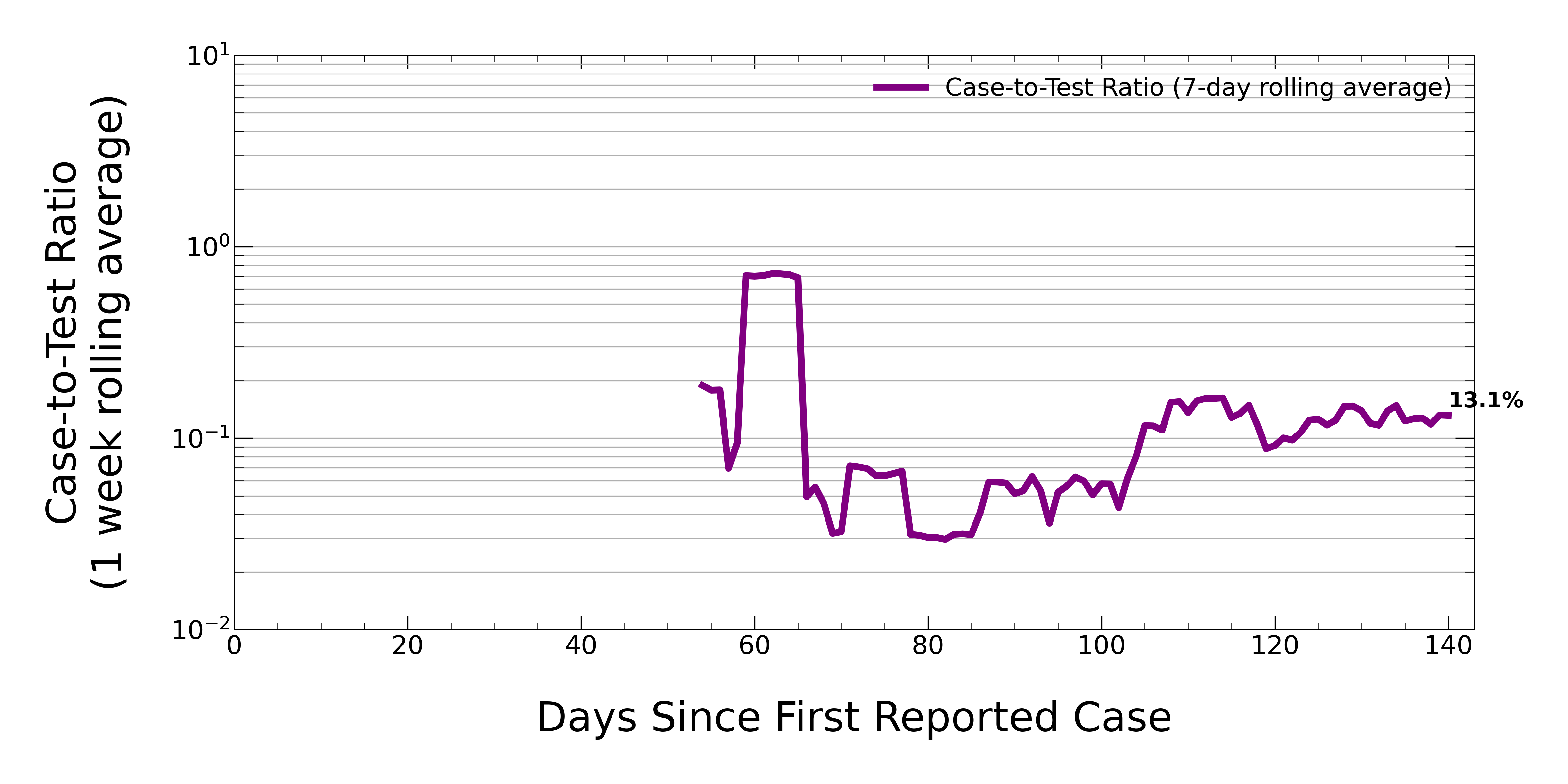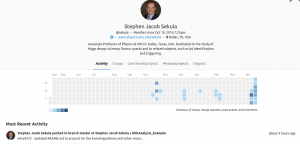
This was quite a week. It began with the long Easter weekend here in the UK, which came to an exceptional end for me on Monday at St. Martin-in-the-Fields for a performance of Handel’s “Messiah” and a night out with (and I love to say these words) my publisher and editor, Otto. Tuesday was a work day at QMUL, and then dinner that evening was with a high-school friend I have not seen in 23 years. The next few days were an intense work period, and today is both “Earth Day” and, more importantly, the day of a global effort to “March for Science.” I took a personal science march in London through pieces of a story that is very important, not only to me, but to the entire world. That story is the story of a pump with no handle.
The end of Easter
The Easter holiday was drawing to a close on Monday. I had been filling my days over the long weekend with intense development work on the ATLAS Hbb framework software. It’s difficult, in writing, to convey the intellectual work of writing, testing, and developing code. It sounds so trivial. You sit on your ass, you type commands into a program, and somehow a bunch of stuff emerges that lives in the mind of the machine and has no physical form and so, to many, also no value.
I’ll come back to coding in a moment, but sufficed to say that after a nap on Monday (knowing I would be up late that night) I was ready to be away from the laptop. I had bought a ticket to see Handel’s “Messiah” at St. Martin-in-the-Fields, a beautiful church on the edge of Trafalgar Square.
I hadn’t planned to see it, but I was very excited to meet, for the first time in person, my editor and publisher, Otto. Otto is president of YBK Publishers in New York and is working hard on finalizing the book I have been co-authoring with retired engineer Frank Blitzer and theoretical physicist Jim Gates. We’ve talked on the phone and in many, many emails, but we’d never overlapped geographically until this last week. We met on the stairs in front of the church just before the performance and then afterward (a tour de force 2 hours performance of the relevant portions of “Messiah”).
We had some drinks at a nearby pub, talked a little about the book and each other’s histories, and wrapped up as midnight approached. The group next to us became interested in our meeting, and we came to find out one of them is heading to New York for a performance of a British play in an “out-of-London” run in the U.S.
Cinnamon Soho
Tuesday was a normal work day at Queen Mary University of London, but that evening I met up with a high school friend of mine whom I had not seen in 23 years. We both graduated high school in 1994, and he went to the UK for college while I remained in the States (he’d come to my high school our junior year when his family moved to our area for work reasons, though he was originally from the UK). Since then, we’d never seen each other but we do follow each other on Facebook. He was in London for work and so we met up at a really nice restaurant in Soho and caught up on many decades of lives lived in different places. It was fantastic to talk to him again, in person, and this was a really unexpected side-benefit of coming to London to work on ATLAS physics.
So much code
As I said above, people misunderstand the effort it takes to create software. Even in my field, software work has an image of a “lazy physicist’s job.” Real physicists make hardware, and those that can’t make hardware write software. It’s a bias, one that will be ferreted out of the community as the line between hardware and software becomes increasingly blurry. But physics is powered by software, and physicists have to write a great deal of it. I enjoy writing software, though I never claimed to be great at it. I just like the intellectual challenge.

I would liken the process of writing code to the process of writing literature. To paraphrase a famous sasying from Ernest Hemingway: “There is nothing to coding. All you do is sit down at an editor and bleed.” This week, my colleague Jon and I bled. He bled dry erase marker on a white board and I bled C++ into my gitlab CERN repositories. Jon used the whiteboard discussions to articulate various architecture ideas that had been rattling around in his head for a very long time. I pushed back on some things, suggested others, changed my mind a few times (we both did some of that), and together we sketched out a roadmap of concrete steps forward in developing new pieces for the Hbb analysis framework that are meant to make life easier for physicists.
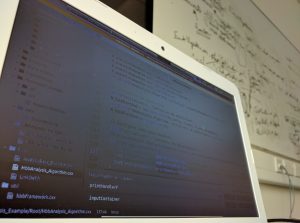
By the end of the week, we had a basic, working set of three key pieces of software (in C++ lingo, three core “classes” that either needed inventing or partial rewriting). They not only compiled (meaning there were no low-hanging bugs in the code that would even prevent the computer from wanting to run it), but they worked. It’s still just a basic demonstrations of all the ideas that were fleshed out first at a workshop last October, but nonetheless we have made a really important series of forward steps toward achieving what we wanted: to make the framework powerful but easier to use.
Some of the students at QMUL are also power users, involved in difficult analyses that required some off-label uses of the existing framework. But while their solutions were off-label but their needs were totally reasonable. Learning more about these cases helps us to make sure we have flexibility and simplicity in what we write. Our goal is to provide a minimum number of things that a physicist needs to worry about setting up, so they can focus on translating physics analysis wants into code and not have to think about the many moving pieces that all need to be separately edited to make even a simple analysis work. Complexity should be possible, but all the software complexity needed to make that happen should be shielded from view of the physicist, freeing them to just code up physics.
That’s the idea, anyway. So far, the example code I have been writing to use these new pieces of software is pretty simple, runs, and can not only be easily read but is partially self-documenting so you know what is happening and when.
The Pump with No Handle: A Personal Science March
I’m just going to say this out loud. While I am supportive of the science marches going on in Washington D.C. and many other cities across the world today, I am suspicious of them. It’s the scientist in me – I am skeptical of the motives of large groups of people, worrying the group will trade individual expertise for mass authority or demand wide conformity to achieve singular purpose. I respect scientists wanting to come together as one voice to speak about the importance of science to society, but I am wary of big gatherings being co-opted by insiders or outsiders (or both) to yet again mar science’s image in society.
I believe every scientist and non-scientist participating in these marches today means well, and will act according to their positive intentions. I also believe that the forces of anti-science will look for my departure from science toward policy positions, any perceived slight to exclude someone from the march for partisan or political reasons, as evidence that science is just a partisan actor.
So I prefer to take a federated approach to the whole thing. Instead of acting in a crowd, I can act in a way that tries to draw attention to science as a process, without worrying what others nearby me are doing. So today, I did my own personal march for science. Sharing it is my way of showing the awesomeness of science.
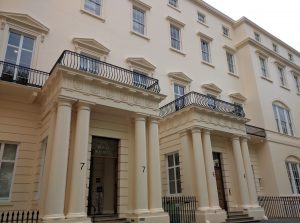
I began by hopping off the Underground at Trafalgar Square and walking over to the building that is home to the Royal Society. This was not my goal, but it was conveniently on the way to where I wanted to be today. It is not open to the public this day, but I chatted with the person at the front desk and then snapped a photo of the facade of the building. I could not help but to think of the history of science that is represented by this organization. I recalled that it was in lectures by Sir Humphrey Davy, then a member of the Royal Society, where a young Michael Faraday came to desire to be part of the march of science. When Davy was injured during one of his experiments, he brought in Faraday as his assistant, having been impressed by a manuscript Faraday had prepared that documented Davy’s lectures. Here, in this one chapter of the history of the Royal Society and some of its members, we have great human tensions. Faraday was a man born of poverty into a highly class-conscious society. Yet through science, Faraday surpassed the achievements of his benefactor and mentor, Davy, who was a well-respected man of “appropriately” high class in British society. Science empowered Faraday, a man whom society might never have otherwise given a serious chance to rise, because science (while difficult) is open to all. You only need the freedom to inquire, the creativity to propose explanations, and the courage to accept what experiments tell you about nature.
I left the Royal Society building and headed north into Soho. Soho, now, is home to rather posh shopping and eating districts, though there are side streets that are still home to some of the seedier businesses that were more a hallmark of Soho-past. I walked past clubs advertising table dancers just a few doors down the street from a small, Catholic elementary school. What juxtapositions. I came into the more fashionable shopping and eating sections of Soho and arrived at Broadwick Street, my ultimate destination.
I was looking for a metal sculpture in the shape of a 19th century hand-powered water pump. After strolling Broadwick for a few minutes, I could not find the sculpture. I consulted the web. In fact, as recently as a few years ago the sculpture was still there. Now, however, it is gone and no one seems to be quite certain when it will return. Standing on the empty sidewalk where once the sculpture stood, I matched up buildings in older photos and continued to my fallback plan: the John Snow pub across the street.
No, this is not “Game of Thrones.” Before there was George R. R. Martin, there was cholera. The John Snow I was interested in was a 19th century physician who investigated the Soho cholera outbreak of 1854. He noted that cases of cholera clustered in a particular region of the city. In addition, people who worked at the local brewery consistently did not contract cholera. While the prevailing hypothesis of the day was that “miasmas” – effluent vapors from cemetaries or sewers – were the source of diseases like cholera, Snow instead turned to an alternative hypothesis to explain the facts that he had observed. He concluded that a well was to blame for the outbreak. This well, located on Broad Street (now Broadwick Street) was where people in the cholera cluster got their water. People who worked at the brewery either didn’t consume water from the well (getting their water fro ma different source) or consumed beer, which would have again meant they were not drinking water from that well.
The story of John Snow is much more complex than I can possibly paint here, but the short of it is this: Snow hypothesized that contaminated well water was the cause, much to the derision of others in the city at the time. He proposed an experiment: remove the handle from the pump. Then people could not drink from the well, and would have to obtain their water from elsewhere. If he was right, the outbreak should subside. If he was wrong, then indeed the cause must be elsewhere. Fundamentally, Snow’s explanation for the outbreak was based on what we now call “the germ theory of disease” – that is, that microorganisms are a source of illness when taken into our bodies, as one would if drinking contaminated water.
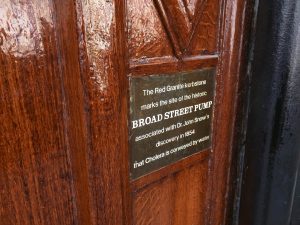
So the handle was removed. And the outbreak subsided. In achieving this discovery, Snow inadvertently launched a new scientific discipline: epidemiology. So his work not only revealed the cause of cholera (contaminated water), ending the Soho cholera outbreak (caused by a well contaminated by the feces from a leaking septic tank that contained cholera from an infected baby diaper), but also invented a new science. Snow is to epidemiology as Galileo is to optical astronomy.
The pump is long gone, and the handle-less pump statue is on hiatus, but there is still a marker on the side of the John Snow pub that commemorates the event. Across from the plaque is a pink-colored stone on the edge of the sidewalk that marks the former location of the Broad Street pump.
Snow’s work can be couched in an over-simplified framework illustrating the scientific method: he observed that cases clustered and that even in the cluster there were people unaffected by the outbreak; he hypothesized based on the observations that what was in common was the use (or not) of water from a specific pump, and thus a specific well; he proposed an experiment to test this claim – the removal of the handle of the pump; the results of the experiment verified the hypothesis and allowed the “germ hypothesis” to survive not only to make new predictions about disease but also to be tested by trying to get rid of the germs (e.g. by washing with soap or other harsh chemicals) to prevent disease.
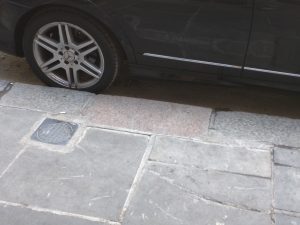
This site, in a bustling shopping and eating district next to an equally bustling pub, marks a crucial moment in human history when the scientific method triumphed, casting aside popular beliefs (miasmas or even punishments from judgmental deities) to instead find the true cause of disease: contamination by microorganisms.
So my science march was a personal journey to a place that commemorates a year when human suffering was lessened by the application of critical thinking and what we now consider to be the scientific method. Science triumphed over ignorance and opinion. The misconceptions of Snow’s day were slowly cast aside over the decades that followed, not only as “germs” came to be better understood (and even began to be directly observed) but as the basis of all biological diversity – the theory of natural selection – came into being from the observations and minds of Charles Darwin and Alfred Russel Wallace just five years after the 1854 Soho cholera outbreak.
So on this day, when many are marching for science, make sure that you have your own personal march for science. Don’t get caught up in the crowd. Crowds have a bad habit of making very bad decisions, or of being wholly blamed for the poor actions of a few individuals. Instead, emphasize through your actions this: science is the only way we humans have of establishing reliable information about the natural world. And everybody needs reliable information.

